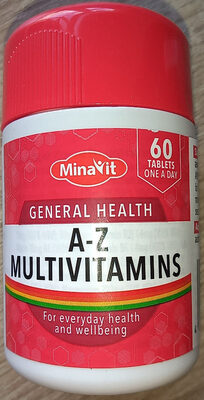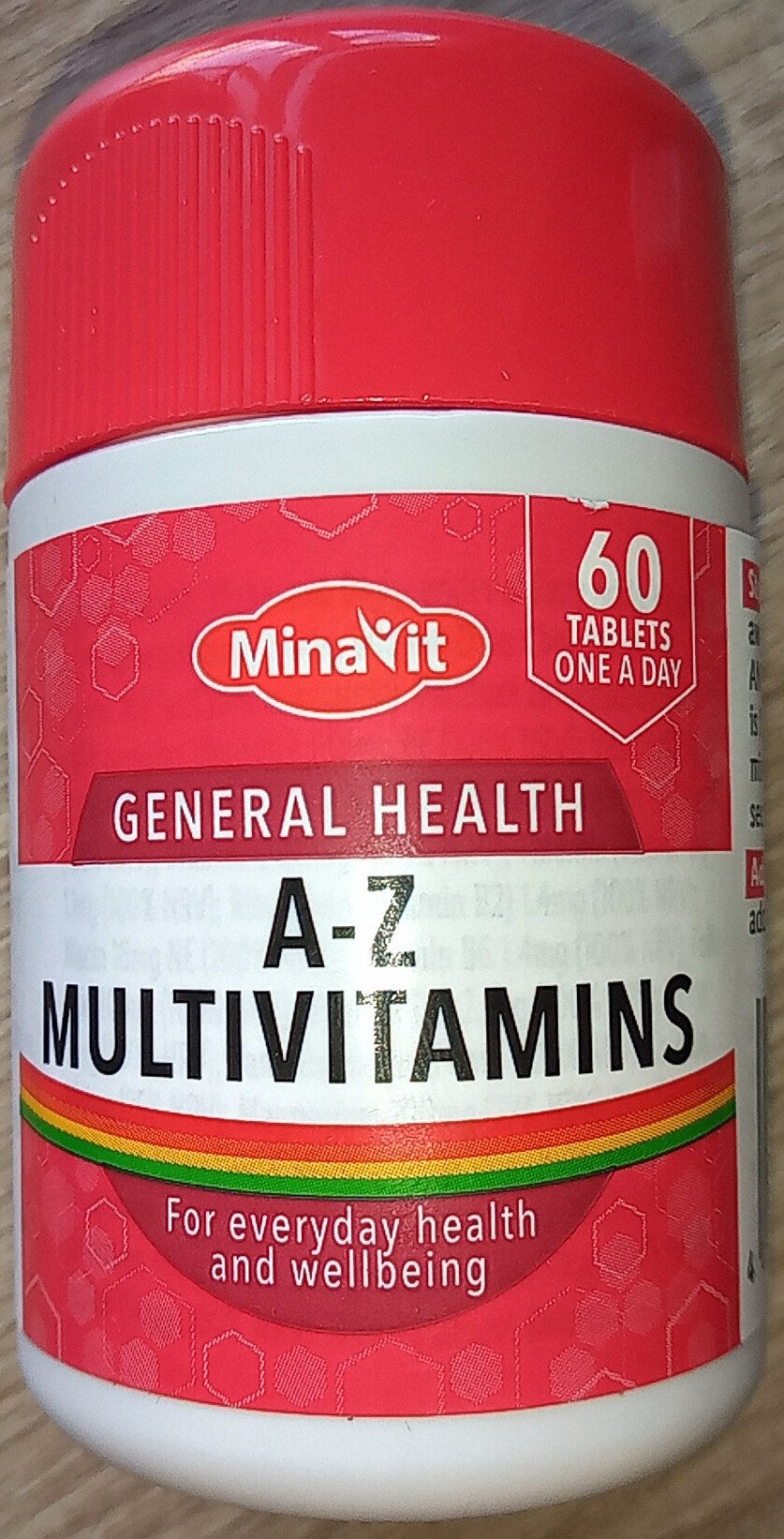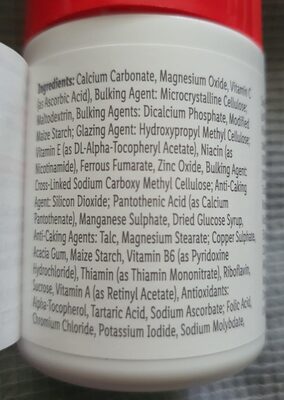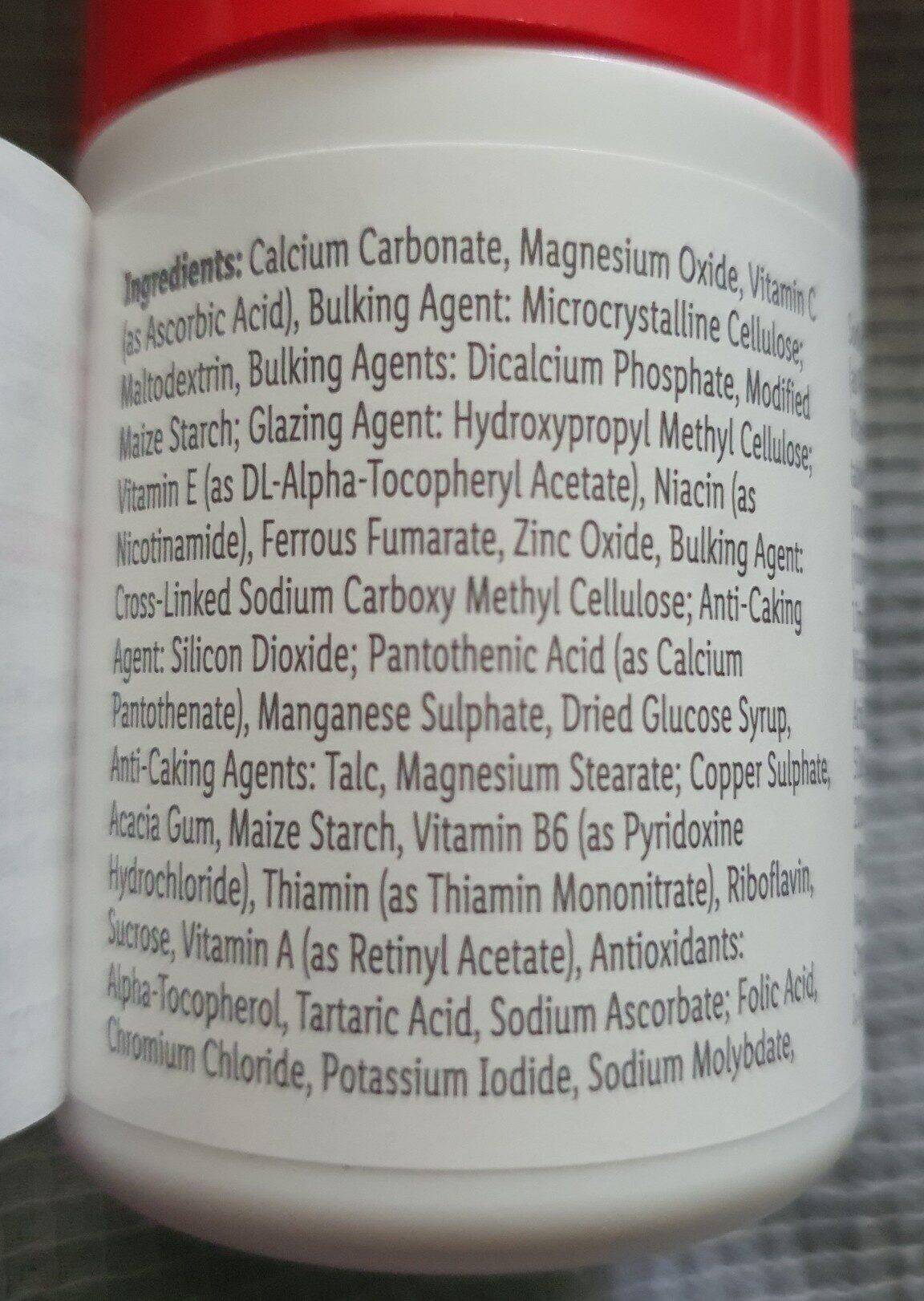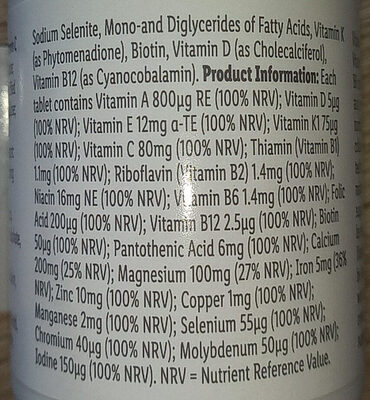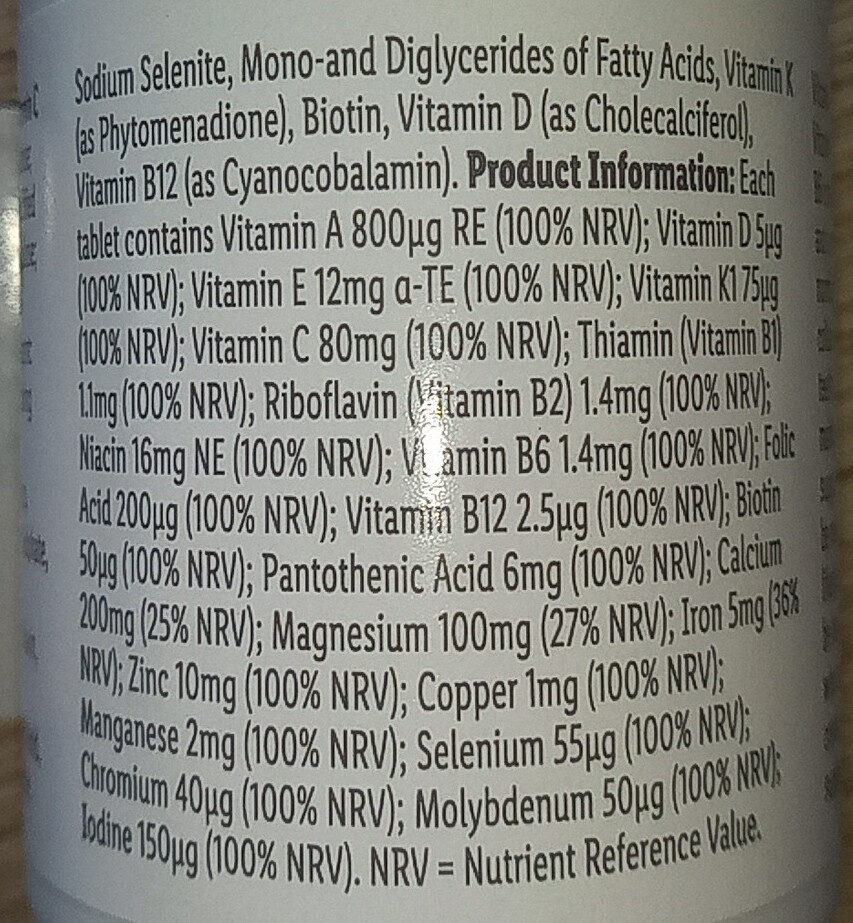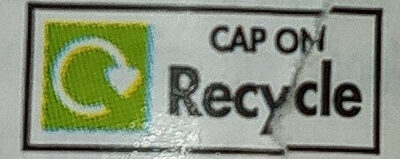Help us make food transparency the norm!
As a non-profit organization, we depend on your donations to continue informing consumers around the world about what they eat.
The food revolution starts with you!
MinaVit A-Z Multivitamins - Lidl
MinaVit A-Z Multivitamins - Lidl
This product page is not complete. You can help to complete it by editing it and adding more data from the photos we have, or by taking more photos using the app for Android or iPhone/iPad. Thank you!
×
Barcode: 4056489437765 (EAN / EAN-13)
Brands: Lidl
Categories: Dietary supplements, Vitamins
Countries where sold: United Kingdom
Matching with your preferences
Health
Ingredients
-
48 ingredients
calcium carbonate, magnesium oxide, vitamin c (as ascorbic acid), bulking agent: microcrystalline cellulose, maltodextrin, bulking agents: dicalcium phosphate, modified maize starch, glazing agent: hydroxypropyl methyl cellulose, vitamin e (as dl-alpha-tocopheryl acetate), niacin (as nicotinamide), ferrous fumarate, zinc oxide, bulking agent: cross-linked sodium carboxy methyl cellulose, anti-caking agent: silicon dioxide, pantothenic acid (as calcium pantothenate), manganese sulphate, dried glucose syrup, anti-caking agents: talc, magnesium stearate, copper sulphate, acacia gum, maize starch, vitamin b6 (as pyridoxine hydrochloride), thiamin (as thiamin mononitrate), riboflavin, sucrose, vitamin a (as retinyl acetate), antioxidants: alpha-tocopherol, tartaric acid, sodium ascorbate, folic acid, chromium chloride, potassium iodide, sodium molybdate
Food processing
-
Ultra processed foods
Elements that indicate the product is in the 4 - Ultra processed food and drink products group:
- Additive: E414 - Acacia gum
- Additive: E460 - Cellulose
- Additive: E464 - Hydroxypropyl methyl cellulose
- Additive: E468 - Cross-linked sodium carboxymethylcellulose
- Additive: E551 - Silicon dioxide
- Ingredient: Bulking agent
- Ingredient: Glazing agent
- Ingredient: Glucose
- Ingredient: Glucose syrup
- Ingredient: Maltodextrin
Food products are classified into 4 groups according to their degree of processing:
- Unprocessed or minimally processed foods
- Processed culinary ingredients
- Processed foods
- Ultra processed foods
The determination of the group is based on the category of the product and on the ingredients it contains.
Additives
-
E301 - Sodium ascorbate
Sodium ascorbate: Sodium ascorbate is one of a number of mineral salts of ascorbic acid -vitamin C-. The molecular formula of this chemical compound is C6H7NaO6. As the sodium salt of ascorbic acid, it is known as a mineral ascorbate. It has not been demonstrated to be more bioavailable than any other form of vitamin C supplement.Sodium ascorbate normally provides 131 mg of sodium per 1‚000 mg of ascorbic acid -1‚000 mg of sodium ascorbate contains 889 mg of ascorbic acid and 111 mg of sodium-. As a food additive, it has the E number E301 and is used as an antioxidant and an acidity regulator. It is approved for use as a food additive in the EU, USA, and Australia and New Zealand.In in vitro studies, sodium ascorbate has been found to produce cytotoxic effects in various malignant cell lines, which include melanoma cells that are particularly susceptible.Source: Wikipedia
-
E307 - Alpha-tocopherol
Alpha-Tocopherol: α-Tocopherol is a type of vitamin E. It has E number "E307". Vitamin E exists in eight different forms, four tocopherols and four tocotrienols. All feature a chromane ring, with a hydroxyl group that can donate a hydrogen atom to reduce free radicals and a hydrophobic side chain which allows for penetration into biological membranes. Compared to the others, α-tocopherol is preferentially absorbed and accumulated in humans.Source: Wikipedia
-
E334 - L(+)-tartaric acid
Tartaric acid: Tartaric acid is a white, crystalline organic acid that occurs naturally in many fruits, most notably in grapes, but also in bananas, tamarinds, and citrus. Its salt, potassium bitartrate, commonly known as cream of tartar, develops naturally in the process of winemaking. It is commonly mixed with sodium bicarbonate and is sold as baking powder used as a leavening agent in food preparation. The acid itself is added to foods as an antioxidant and to impart its distinctive sour taste. Tartaric is an alpha-hydroxy-carboxylic acid, is diprotic and aldaric in acid characteristics, and is a dihydroxyl derivative of succinic acid.Source: Wikipedia
-
E341 - Calcium phosphates
Calcium phosphate: Calcium phosphate is a family of materials and minerals containing calcium ions -Ca2+- together with inorganic phosphate anions. Some so-called calcium phosphates contain oxide and hydroxide as well. They are white solids of nutritious value.Source: Wikipedia
-
E341ii - Dicalcium phosphate
Calcium phosphate: Calcium phosphate is a family of materials and minerals containing calcium ions -Ca2+- together with inorganic phosphate anions. Some so-called calcium phosphates contain oxide and hydroxide as well. They are white solids of nutritious value.Source: Wikipedia
-
E414 - Acacia gum
Gum arabic: Gum arabic, also known as acacia gum, arabic gum, gum acacia, acacia, Senegal gum and Indian gum, and by other names, is a natural gum consisting of the hardened sap of various species of the acacia tree. Originally, gum arabic was collected from Acacia nilotica which was called the "gum arabic tree"; in the present day, gum arabic is collected from acacia species, predominantly Acacia senegal and Vachellia -Acacia- seyal; the term "gum arabic" does not indicate a particular botanical source. In a few cases so‐called "gum arabic" may not even have been collected from Acacia species, but may originate from Combretum, Albizia or some other genus. Producers harvest the gum commercially from wild trees, mostly in Sudan -80%- and throughout the Sahel, from Senegal to Somalia—though it is historically cultivated in Arabia and West Asia. Gum arabic is a complex mixture of glycoproteins and polysaccharides. It is the original source of the sugars arabinose and ribose, both of which were first discovered and isolated from it, and are named after it. Gum arabic is soluble in water. It is edible, and used primarily in the food industry as a stabilizer, with EU E number E414. Gum arabic is a key ingredient in traditional lithography and is used in printing, paint production, glue, cosmetics and various industrial applications, including viscosity control in inks and in textile industries, though less expensive materials compete with it for many of these roles. While gum arabic is now produced throughout the African Sahel, it is still harvested and used in the Middle East.Source: Wikipedia
-
E460 - Cellulose
Cellulose: Cellulose is an organic compound with the formula -C6H10O5-n, a polysaccharide consisting of a linear chain of several hundred to many thousands of β-1→4- linked D-glucose units. Cellulose is an important structural component of the primary cell wall of green plants, many forms of algae and the oomycetes. Some species of bacteria secrete it to form biofilms. Cellulose is the most abundant organic polymer on Earth. The cellulose content of cotton fiber is 90%, that of wood is 40–50%, and that of dried hemp is approximately 57%.Cellulose is mainly used to produce paperboard and paper. Smaller quantities are converted into a wide variety of derivative products such as cellophane and rayon. Conversion of cellulose from energy crops into biofuels such as cellulosic ethanol is under development as a renewable fuel source. Cellulose for industrial use is mainly obtained from wood pulp and cotton.Some animals, particularly ruminants and termites, can digest cellulose with the help of symbiotic micro-organisms that live in their guts, such as Trichonympha. In human nutrition, cellulose is a non-digestible constituent of insoluble dietary fiber, acting as a hydrophilic bulking agent for feces and potentially aiding in defecation.Source: Wikipedia
-
E460i - Microcrystalline cellulose
Cellulose: Cellulose is an organic compound with the formula -C6H10O5-n, a polysaccharide consisting of a linear chain of several hundred to many thousands of β-1→4- linked D-glucose units. Cellulose is an important structural component of the primary cell wall of green plants, many forms of algae and the oomycetes. Some species of bacteria secrete it to form biofilms. Cellulose is the most abundant organic polymer on Earth. The cellulose content of cotton fiber is 90%, that of wood is 40–50%, and that of dried hemp is approximately 57%.Cellulose is mainly used to produce paperboard and paper. Smaller quantities are converted into a wide variety of derivative products such as cellophane and rayon. Conversion of cellulose from energy crops into biofuels such as cellulosic ethanol is under development as a renewable fuel source. Cellulose for industrial use is mainly obtained from wood pulp and cotton.Some animals, particularly ruminants and termites, can digest cellulose with the help of symbiotic micro-organisms that live in their guts, such as Trichonympha. In human nutrition, cellulose is a non-digestible constituent of insoluble dietary fiber, acting as a hydrophilic bulking agent for feces and potentially aiding in defecation.Source: Wikipedia
-
E464 - Hydroxypropyl methyl cellulose
Hypromellose: Hypromellose -INN-, short for hydroxypropyl methylcellulose -HPMC-, is a semisynthetic, inert, viscoelastic polymer used as eye drops, as well as an excipient and controlled-delivery component in oral medicaments, found in a variety of commercial products.As a food additive, hypromellose is an emulsifier, thickening and suspending agent, and an alternative to animal gelatin. Its Codex Alimentarius code -E number- is E464.Source: Wikipedia
-
E551 - Silicon dioxide
Silicon dioxide: Silicon dioxide, also known as silica, silicic acid or silicic acid anydride is an oxide of silicon with the chemical formula SiO2, most commonly found in nature as quartz and in various living organisms. In many parts of the world, silica is the major constituent of sand. Silica is one of the most complex and most abundant families of materials, existing as a compound of several minerals and as synthetic product. Notable examples include fused quartz, fumed silica, silica gel, and aerogels. It is used in structural materials, microelectronics -as an electrical insulator-, and as components in the food and pharmaceutical industries. Inhaling finely divided crystalline silica is toxic and can lead to severe inflammation of the lung tissue, silicosis, bronchitis, lung cancer, and systemic autoimmune diseases, such as lupus and rheumatoid arthritis. Uptake of amorphous silicon dioxide, in high doses, leads to non-permanent short-term inflammation, where all effects heal.Source: Wikipedia
-
E572 - Magnesium stearate
Magnesium stearate: Magnesium stearate is the chemical compound with the formula Mg-C18H35O2-2. It is a soap, consisting of salt containing two equivalents of stearate -the anion of stearic acid- and one magnesium cation -Mg2+-. Magnesium stearate is a white, water-insoluble powder. Its applications exploit its softness, insolubility in many solvents, and low toxicity. It is used as a release agent and as a component or lubricant in the production of pharmaceuticals and cosmetics.Source: Wikipedia
Ingredients analysis
-
Palm oil free
No ingredients containing palm oil detected
-
Vegan status unknown
Unrecognized ingredients: Vitamin C, Vitamin E, DL-alpha tocopheryl acetate, Iron fumarate, Zinc oxide, Manganese sulfate, Thiamin, Thiamin mononitrate, Folic acid, Chromium chloride, Sodium molybdate
-
Vegetarian status unknown
Unrecognized ingredients: Vitamin C, Vitamin E, DL-alpha tocopheryl acetate, Iron fumarate, Zinc oxide, Manganese sulfate, Thiamin, Thiamin mononitrate, Folic acid, Chromium chloride, Sodium molybdate
-
Details of the analysis of the ingredients
: calcium carbonate, magnesium oxide, vitamin c (as ascorbic acid), bulking agent (microcrystalline cellulose), maltodextrin, bulking agents (dicalcium phosphate), modified maize starch, glazing agent (hydroxypropyl methyl cellulose), vitamin e (as dl-alpha-tocopheryl acetate), niacin (as nicotinamide), ferrous fumarate, zinc oxide, bulking agent (cross-linked sodium carboxy methyl cellulose), anti-caking agent (silicon dioxide), pantothenic acid (as calcium pantothenate), manganese sulphate, dried glucose syrup, anti-caking agents (talc), magnesium stearate, copper sulphate, acacia gum, maize starch, vitamin b6 (as pyridoxine hydrochloride), thiamin (as thiamin mononitrate), riboflavin, sucrose, vitamin a (as retinyl acetate), antioxidants (alpha-tocopherol), tartaric acid, sodium ascorbate, folic acid, chromium chloride, potassium iodide, sodium molybdate- calcium carbonate -> en:e170i - vegan: maybe - vegetarian: maybe - percent_min: 2.94117647058824 - percent_max: 100
- magnesium oxide -> en:e530 - vegan: yes - vegetarian: yes - percent_min: 0 - percent_max: 50
- vitamin c -> en:vitamin-c - percent_min: 0 - percent_max: 33.3333333333333
- as ascorbic acid -> en:e300 - vegan: yes - vegetarian: yes - percent_min: 0 - percent_max: 33.3333333333333
- bulking agent -> en:bulking-agent - percent_min: 0 - percent_max: 25
- microcrystalline cellulose -> en:e460i - vegan: yes - vegetarian: yes - percent_min: 0 - percent_max: 25
- maltodextrin -> en:maltodextrin - vegan: yes - vegetarian: yes - percent_min: 0 - percent_max: 20
- bulking agents -> en:bulking-agent - percent_min: 0 - percent_max: 16.6666666666667
- dicalcium phosphate -> en:e341ii - vegan: yes - vegetarian: yes - percent_min: 0 - percent_max: 16.6666666666667
- modified maize starch -> en:modified-corn-starch - vegan: yes - vegetarian: yes - ciqual_food_code: 9510 - percent_min: 0 - percent_max: 14.2857142857143
- glazing agent -> en:glazing-agent - percent_min: 0 - percent_max: 12.5
- hydroxypropyl methyl cellulose -> en:e464 - vegan: yes - vegetarian: yes - percent_min: 0 - percent_max: 12.5
- vitamin e -> en:vitamin-e - percent_min: 0 - percent_max: 11.1111111111111
- as dl-alpha-tocopheryl acetate -> en:dl-alpha-tocopheryl-acetate - percent_min: 0 - percent_max: 11.1111111111111
- niacin -> en:e375 - vegan: maybe - vegetarian: maybe - percent_min: 0 - percent_max: 10
- as nicotinamide -> en:e375 - vegan: maybe - vegetarian: maybe - percent_min: 0 - percent_max: 10
- ferrous fumarate -> en:iron-fumarate - percent_min: 0 - percent_max: 9.09090909090909
- zinc oxide -> en:zinc-oxide - percent_min: 0 - percent_max: 8.33333333333333
- bulking agent -> en:bulking-agent - percent_min: 0 - percent_max: 7.69230769230769
- cross-linked sodium carboxy methyl cellulose -> en:e468 - vegan: yes - vegetarian: yes - percent_min: 0 - percent_max: 7.69230769230769
- anti-caking agent -> en:anti-caking-agent - percent_min: 0 - percent_max: 7.14285714285714
- silicon dioxide -> en:e551 - vegan: yes - vegetarian: yes - percent_min: 0 - percent_max: 7.14285714285714
- pantothenic acid -> en:pantothenic-acid - vegan: yes - vegetarian: yes - percent_min: 0 - percent_max: 6.66666666666667
- as calcium pantothenate -> en:calcium-pantothenate - vegan: yes - vegetarian: yes - percent_min: 0 - percent_max: 6.66666666666667
- manganese sulphate -> en:manganese-sulfate - percent_min: 0 - percent_max: 6.25
- dried glucose syrup -> en:dehydrated-glucose-syrup - vegan: yes - vegetarian: yes - ciqual_proxy_food_code: 31016 - percent_min: 0 - percent_max: 5.88235294117647
- anti-caking agents -> en:anti-caking-agent - percent_min: 0 - percent_max: 5.55555555555556
- talc -> en:e553b - vegan: yes - vegetarian: yes - percent_min: 0 - percent_max: 5.55555555555556
- magnesium stearate -> en:e572 - vegan: maybe - vegetarian: maybe - percent_min: 0 - percent_max: 5.26315789473684
- copper sulphate -> en:e519 - vegan: yes - vegetarian: yes - percent_min: 0 - percent_max: 5
- acacia gum -> en:e414 - vegan: yes - vegetarian: yes - percent_min: 0 - percent_max: 4.76190476190476
- maize starch -> en:corn-starch - vegan: yes - vegetarian: yes - ciqual_food_code: 9510 - percent_min: 0 - percent_max: 4.54545454545455
- vitamin b6 -> en:vitamin-b6 - vegan: yes - vegetarian: yes - percent_min: 0 - percent_max: 4.34782608695652
- as pyridoxine hydrochloride -> en:pyridoxine-hydrochloride - vegan: yes - vegetarian: yes - percent_min: 0 - percent_max: 4.34782608695652
- thiamin -> en:thiamin - percent_min: 0 - percent_max: 4.16666666666667
- as thiamin mononitrate -> en:thiamin-mononitrate - percent_min: 0 - percent_max: 4.16666666666667
- riboflavin -> en:e101 - vegan: maybe - vegetarian: yes - percent_min: 0 - percent_max: 4
- sucrose -> en:sucrose - vegan: yes - vegetarian: yes - ciqual_proxy_food_code: 31016 - percent_min: 0 - percent_max: 3.84615384615385
- vitamin a -> en:vitamin-a - vegan: yes - vegetarian: yes - percent_min: 0 - percent_max: 3.7037037037037
- as retinyl acetate -> en:retinyl-acetate - vegan: yes - vegetarian: yes - percent_min: 0 - percent_max: 3.7037037037037
- antioxidants -> en:antioxidant - percent_min: 0 - percent_max: 3.57142857142857
- alpha-tocopherol -> en:e307 - vegan: yes - vegetarian: yes - percent_min: 0 - percent_max: 3.57142857142857
- tartaric acid -> en:e334 - vegan: yes - vegetarian: yes - percent_min: 0 - percent_max: 3.44827586206897
- sodium ascorbate -> en:e301 - vegan: yes - vegetarian: yes - percent_min: 0 - percent_max: 3.33333333333333
- folic acid -> en:folic-acid - percent_min: 0 - percent_max: 3.2258064516129
- chromium chloride -> en:chromium-chloride - percent_min: 0 - percent_max: 3.125
- potassium iodide -> en:potassium-iodide - vegan: yes - vegetarian: yes - ciqual_food_code: 11058 - percent_min: 0 - percent_max: 3.03030303030303
- sodium molybdate -> en:sodium-molybdate - percent_min: 0 - percent_max: 2.94117647058824
Nutrition
-
Missing data to compute the Nutri-Score
Missing nutrition facts
⚠ ️The nutrition facts of the product must be specified in order to compute the Nutri-Score.Could you add the information needed to compute the Nutri-Score? Add nutrition facts
-
Nutrition facts
Nutrition facts As sold
per servingCompared to: Vitamins Fat ? Saturated fat ? Carbohydrates ? Sugars ? Fiber ? Proteins ? Salt ? Vitamin A 0 µg Vitamin D 0 µg Vitamin E 0 mg Vitamin K 0 µg Vitamin C (ascorbic acid) 0 mg Vitamin B1 (Thiamin) 0 mg Vitamin B2 (Riboflavin) 0 mg Vitamin B3/PP (Niacin) 0 mg Vitamin B6 (Pyridoxin) 0 mg Vitamin B9 (Folic acid) 0 µg Vitamin B12 (cobalamin) 0 µg Vitamin B5 (Pantothenic acid) 0 mg Calcium 0 mg Iron 0 mg Magnesium 0 mg Zinc 0 mg Copper 0 mg Manganese 0 mg Selenium 0 µg Chromium 0 µg Molybdenum 0 µg Iodine 0 µg Fruits‚ vegetables‚ nuts and rapeseed‚ walnut and olive oils (estimate from ingredients list analysis) 0 %
Environment
-
Eco-Score not computed - Unknown environmental impact
We could not compute the Eco-Score of this product as it is missing some data, could you help complete it?Could you add a precise product category so that we can compute the Eco-Score? Add a category
Packaging
-
Missing packaging information for this product
⚠ ️ The information about the packaging of this product is not filled in.Take a photo of the recycling information Take a photo of the recycling information
Transportation
-
Origins of ingredients
Missing origins of ingredients information
⚠ ️ The origins of the ingredients of this product are not indicated.
If they are indicated on the packaging, you can modify the product sheet and add them.
If you are the manufacturer of this product, you can send us the information with our free platform for producers.Add the origins of ingredients for this product Add the origins of ingredients for this product
Report a problem
-
Incomplete or incorrect information?
Category, labels, ingredients, allergens, nutritional information, photos etc.
If the information does not match the information on the packaging, please complete or correct it. Open Food Facts is a collaborative database, and every contribution is useful for all.
Data sources
Product added on by inf
Last edit of product page on by roboto-app.
Product page also edited by 20180911, 2819, openfoodfacts-contributors.
